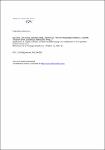Application of a split luciferase complementation assay for the detection of viral protein–protein interactions
Deng, Qiji
Wang, Dan
Xiang, Xiaoxiao
Gao, Xiaofei
Hardwidge, Philip R.
Kaushik, Radhey S.
Wolff, Thorsten
Chakravarty, Suvobrata
Li, Feng
Intraviral protein-protein interactions are critical for virus survival in the host. Discovery of such interactions is important to understand molecular mechanisms of viral replication and pathogenesis. The development of a cell-based assay that can be employed to examine systematically viral protein interactions is described. The method, known as the split luciferase complementation assay (SLCA), is based on the principle that N- and C-terminal domains of luciferase alone do not emit luminescence; however, if fused to interacting proteins the two non-functional halves can be brought into close enough proximity through a specific protein-protein interaction to restore the functions of the enzyme and emit detectable light. The well-studied influenza B polymerase acidic protein (PA) and basic protein 1 (PB1) interaction was used as a model system to develop the assay. Consistent with previous studies, a strong PA-PB1 interaction was demonstrated in the assay. The PA-PB1 interaction was also disrupted by single amino acid mutations in the N-terminal domain of PB1 that is responsible for binding PA. The described SLCA is highly specific and easy to perform, and thus may be useful for studying protein-protein interactions in viral diseases.
No license information

